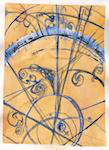Speaker
Description
Quarkonium (a bound state of $Q\bar{Q}$ pair) production as a function of charged-particle multiplicity has been measured in pp collisions at the LHC. They exhibit a non-trivial correlation that can lead to a better understanding of the multiple-parton interaction mechanism in the initial state of the collision as well as possible collective effects in small systems. The ALICE detector at the LHC measures quarkonium production down to zero transverse momentum in different rapidity intervals (mid-rapidity (|y| < 0.9)) and forward rapidity (2.5 < y < 4)). Charmonia ($J/\psi$, $c\bar{c}$) are detected via their decay into di-electrons at mid-rapidity and dimuons at forward rapidity. Bottomonia ($\Upsilon$, $b\bar{b}$) are detected via their decay into dimuons at forward rapidity. Charged-particle multiplicity is measured using track segments in the silicon pixel detector in $|\eta|$ < 1.
In this presentation we will present latest ALICE measurements for relative $J/\psi$ and $\Upsilon$ production as a function of multiplicity in pp collisions at $\sqrt{s} =$13 TeV. The relative $J/\psi$ or $\Upsilon$ yield is the ratio between the $J/\psi$ or $\Upsilon$ yield measured in a certain multiplicity interval to the multiplicity-integrated yield. The relative $J/\psi$ yields at forward rapidity as a function of charged-particle multiplicity will be presented and compared to previous results at mid-rapidity. We will discuss the first measurement of the relative $\Upsilon$(1S) and $\Upsilon$(2S) yields at forward rapidity as a function of the charged-particle multiplicity. In the forward rapidity region, ratios of the relative $\Upsilon$(2S) over $\Upsilon$(1S) and $\Upsilon$(1S) over $J/\psi$ yields as a function of charged-particle multiplicity will also be presented.




